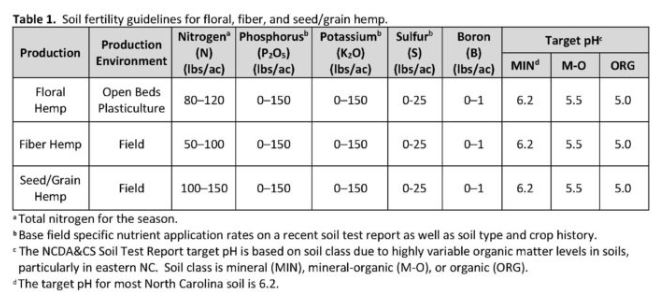Apeks Supercritical Introduces Ethanol Co-Solvent for Extraction Process
Marijuana Industry News June 12, 2020 MJ Shareholders
As the hemp industry in North Carolina finds its sea legs during its initial growing seasons in a federally legal market, the North Carolina Department of Agriculture and Consumer Services (NCDA&CS) is working to help farmers address common challenges and yield better crops. Most recently, the NCDA&CS’s Agronomic Division released new guidelines, prepared by Agronomic Field Services Section Chief Dr. Michelle McGinnis, to help hemp farmers manage soil fertility and plant nutrition, and prepare samples for leaf tissue testing.
The “Managing Hemp Soil Fertility in North Carolina” guidelines specify target nutrient ranges (in pounds per acre), including nitrogen, phosphorous, potassium, sulfur and boron, as well as target pH, for hemp grown for flower, fiber and seed/grain. (“Actual nutrient and lime application rates should be based on a soil test report,” said McGinnis.)
The “Leaf Tissue Sampling for Floral Hemp” guidelines can help farmers monitor in-season fertility and diagnose plant growth problems. “Leaf tissue analysis is a great tool, but you need to have accurate nutrient ranges to compare results to,” she said. “The nutrient survey ranges that most agronomic labs and ag advisors use are those listed in Bryson & Mills, 2014, ‘Plant Analysis Handbook IV,’” she said. “This is a great framework, but we needed to modify the nutrient ranges for NC production. The nutrient ranges are based on ranges published in Bryson & Mills with modifications specific to North Carolina agriculture, based on 2019 North Carolina State University/North Carolina Department of Agriculture floral hemp research, 2019 cultivar survey data, and on-farm observations and tissue analysis results by the regional agronomist in 2018 and 2019.” (See Table 1.)
“In the Field Services Section, the regional agronomists provide on-farm consultations, collect samples, diagnose plant growth problems, and provide the farmer recommendations,” said McGinnis. With 2018 being the first year the state’s farmers got their hemp crops in on time, “growers were calling and asking, ‘What do I need to do? What’s the problem? What do I need to fertilize with?’ So that’s really where a lot of this came from,” she said.
Testing was also a challenge for new growers, McGinnis said, and knowing how to collect plant samples for nutrient testing is not an intuitive process. “The biggest concern I have is that people were using the tissue testing results to make management decisions,” she said. “And if they’re not collecting the tissue samples properly, they’re basing it on wrong information.”
Find the guidelines, which have been published by the North Carolina State University Hemp Extension, here, and reach Dr. McGinnis at Michelle.McGinnis@ncagr.gov.
MJ Shareholders
MJShareholders.com is the largest dedicated financial network and leading corporate communications firm serving the legal cannabis industry. Our network aims to connect public marijuana companies with these focused cannabis audiences across the US and Canada that are critical for growth: Short and long term cannabis investors Active funding sources Mainstream media Business leaders Cannabis consumers









